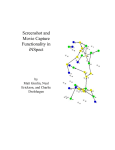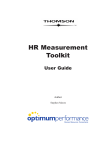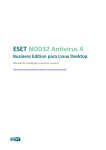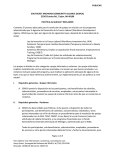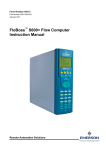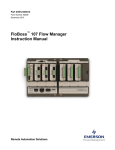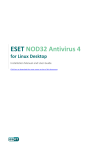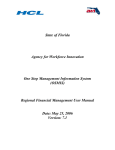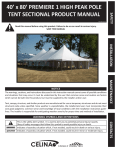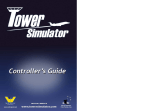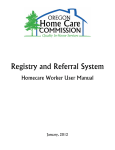Download SKIES Reference Manual - Southwest Washington Workforce
Transcript
SKIES User Reference Manual Southwest Washington Workforce Development Council TABLE OF CONTENTS Introduction .................................................................................................................................................................................. 3 Case Notes .................................................................................................................................................................................... 4 Certificates and Credential Measure ..................................................................................................................................... 6 Definition ................................................................................................................................................................................... 6 Certificates Countable Towards Federal Common Measure...................................................................................... 6 Credentials Countable Toward State Measures............................................................................................................. 7 How to Enter Data into SKIES ............................................................................................................................................ 8 Current Participant............................................................................................................................................................. 8 Exited Participant................................................................................................................................................................ 9 Documentation.................................................................................................................................................................. 11 Changes to SKIES ..................................................................................................................................................................... 12 SKIES Assistance................................................................................................................................................................... 12 Co-enrolled Participants .......................................................................................................................................................... 13 Entered Employment................................................................................................................................................................ 14 Apprenticeships ..................................................................................................................................................................... 16 Self Employment ................................................................................................................................................................... 16 Follow Up Services.................................................................................................................................................................... 17 Free Form Text standards in SKIES .................................................................................................................................... 19 Demand Occupations .......................................................................................................................................................... 19 Educational Institutions ...................................................................................................................................................... 19 Employer Names ................................................................................................................................................................... 19 Global exclusions....................................................................................................................................................................... 20 ITA Entry into SKIES ................................................................................................................................................................ 21 Literacy and Numeracy Measure.......................................................................................................................................... 23 Performance Quarters in a Calendar Year ........................................................................................................................ 26 Program Validation ................................................................................................................................................................... 27 OJT entry into SKIES ............................................................................................................................................................... 29 Seeker services .......................................................................................................................................................................... 31 Soft Exit Strategies ................................................................................................................................................................... 32 Transfer a file ............................................................................................................................................................................. 33 Key Definitions ........................................................................................................................................................................... 34 Available Resources.................................................................................................................................................................. 40 Appendix ...................................................................................................................................................................................... 41 Attachment Attachment Attachment Attachment A Certificates Policy ...................................................................................................................................... 41 B Educational Institutions........................................................................................................................... 41 C WIA Adult-DW Common Performance Measures............................................................................ 41 D WIA Youth Measures ............................................................................................................................... 41 -2Revised 9/2010 AG INTRODUCTION The following manual was developed to help assist Workforce Investment Act (WIA) staff with frequently asked questions regarding SKIES and general case management. This manual is to be used in Southwest Washington Workforce Development area only as some of things items discussed pertain to local policies. The SW Washington area counties include Clark, Cowlitz, and Wahkiakum. This manual is intended for WIA staff with some SKIES experience. It was not intended to replace the SKIES User Manual where you will find specific SKIES data entry processes. Follow this link for the SKIES User Guides http://www.wa.gov/esd/skies/training/guide/staff.htm. -3Revised 9/2010 AG CASE NOTES Entering case notes into SKIES is a crucial process when documenting a WIA participant’s activities. If there is any discrepancy during an audit or while pulling performance data, staff will look through the participant’s case notes for clarification. It is important to enter case notes at minimum every 90 days. Case notes should continue through the participant’s year of follow up service. For those case managers that work with Adult and Dislocated Workers and serve participants that are under the 175% of poverty level. You must enter “175% PL” in the comments section of the SKIES Program Enrollment Screen. This helps when pulling local reports. Use the following steps to enter case notes into SKIES: 1. After searching for participant in SKIES, click on note pad in the top middle of the screen. Enter case notes in sequential order. Case notes will print if necessary. See screen shot. -4Revised 9/2010 AG 2. During year of follow up, enter information in the contact log of the follow up service plan. Use the same process as above. See screen shot below of SKIES follow up contact log. -5Revised 9/2010 AG CERTIFICATES AND CREDENTIAL MEASURE For the certificate/credential common measure, the following are guidelines written to help determine an acceptable certificate or credential and how to document in SKIES. The certificate or credential must be attained by the end of 3rd quarter after exit. The state released Certificates and Credentials Under Common Measures Policy #3690 and TEGL 17-05 distinguishes credentials from certificates by the following definitions. Definition A certificate is awarded in recognition of an individual’s attainment of measurable technical or occupational skills necessary to gain employment or advance within an occupation. The new certificate definition applies to those participants who began receiving services on or after July 1, 2006. A credential is nationally recognized degree or certificate or State/locally recognized credential. The credential definition applies to those participants who started receiving services before July 1, 2006. This term only applies to WIA Adult, Dislocated Worker, and Older Youth Performance Measures. Not the WIA Common Measures. The definition of credential applies to the WIA Employment and Credential Measure and allows for locally recognized credentials while the more prescriptive definition of a certificate applies to the youth common measure and does not permit local board-recognized certificates nor work readiness certificates. Certificates Countable Towards Federal Common Measure The new definition of certificate is applicable to WIA 1-B Employment and Credential Rates for adults, dislocated workers, and older youth (19-21 as in the performance measures) who began receiving WIAfunded services on or after July 1, 2006. The credential definition applies to adults and older youth who started receiving WIA services before July 1, 2006. Receiving services means receiving any countable service, not just training services. The tightened definition sets a high, national standard for certificates intended to insure that certificates counted toward WIA 1-B performance measure the attainment of measurable technical or occupational skills and that performance will be tracked consistently across the states. The new federal definition also sets standards for the types of institutions and training organizations which may award certificates that count toward WIA 1-B performance measures. These include: Certificates granted by institutions of higher education An institution eligible to participate in federally funded student financial aid programs. (Typically, this means that the program must be accredited by the appropriate accreditation body.) Programs of study shorter than 600 hours are not eligible for federal financial aid. However, programs of study shorter than 600 hours produce countable occupational skills certificates as long as the school offering the program is an institution of higher education eligible to participate in federally funded student financial aid programs. Certificates granted by a professional, industry or employer organization. Employer organization must be a professional, industry or employer organization, product manufacturer or developer using a valid and reliable assessment of an individual’s knowledge, skills, and abilities. -6Revised 9/2010 AG Certificates granted by a registered apprenticeship program. This is regulated by the Department of Labor and Industries. Certificates granted by a public regulatory agency Upon completion of an individual’s fulfillment of educational, work experience, or skill requirements that are legally necessary to use an occupational title or practice an occupation or profession. Examples of public certification and licensing agencies include the Department of Health, Nursing Commission, Massage Board, Washington State Patrol, Department of Social and Health Services (Day Care Providers), Department of Labor and Industries (Contractor Licenses and various licenses and certificates related to the trades), Department of Licensing issued Commercial Driver’s License. Regular driver’s licenses and county food handler’s cards do not have enough of a training component to qualify. Certificates granted by a program approved by the Department of Veteran’s Affairs Program approved by the Department of Veteran’s Affairs to offer education benefits to veterans and other eligible persons. The Workforce Board’s website will list the Washington State VA approved programs. Certificates granted by Job Corps centers. Certificates granted by institutions of higher education Institutions of higher education controlled, sanctioned, or chartered by the governing body of an Indian tribe or tribes. Credentials Countable Toward State Measures In addition to the certificates countable toward federal performance, three types of credentials are countable toward State core measures of performance: Successful Completion of a Work-Based Training Plan Successful completion of an On-the-Job Training plan approved by a local Workforce Development Council is countable as a credential toward State credential rates for adult and dislocated worker populations. Successful completion of a Work Experience Training plan approved by a local Workforce Development Council is countable as a credential toward State credential rates for youth populations. Work Readiness Credentials Standardized, validated, work readiness credentials that measure non-technical work readiness skills that are needed by employers are countable toward state credential measures. A work readiness credential demonstrates the ability to apply situational judgment, reading, math, and communication skills in a work-related context. The National Work Readiness Credential is one credential that meets this standard. Photocopies of work readiness credentials should be retained in case files to document attainment of this credential. The date of credential attainment should be recorded in case files and in SKIES. Credentials Granted by Eligible Training Providers Credentials granted by eligible training providers licensed as Private Career Schools by the State of Washington. A diploma, certificate or award from a program offered by a private career schools licensed by the State of Washington can be counted toward state -7Revised 9/2010 AG credential rates if the diploma, certificate or award is countable as a federal occupational skills certificate. If the diploma, certificate or award from a private career school licensed by the State of Washington is not countable as a federal certificate, it counts as a state credential if the program is on the Washington State Eligible Training Provider (ETP) List, as long as the occupation trained for does not require a license to practice. If a license is required to practice an occupation or profession, such as cosmetology, real estate, and nursing or massage therapy, and the ETP List program is not countable as a federal occupational skills certificate, then completion of such a program does not count toward state core measures credential rates. For example, completion of an ETP List program in cosmetology by an institution or organization that is not eligible to issue a certificate under the federal common measures definition would not qualify as a State core measures credential because a student could not practice cosmetology without a license. However, attainment of the cosmetology license is countable as a federal certificate (Occupational Skills License) and, therefore, as a state credential. Given the changes at the federal level, application of the federal common measures certificate definitions will no longer allow Washington State to count four types of credentials toward WIA 1-B adult, dislocated worker, and youth performance (for services started on or after July 1, 2006). The four types are: Credentials granted by Local Workforce Board Local Workforce Board policy for the successful completion of on-the-job training program in the absence of an industry based skill certificate based on a valid and reliable assessment of an individual’s knowledge, skills, and abilities. Credentials granted by training programs Training programs approved for inclusion on Washington State’s Eligible Training Provider List for programs included on that list that do not meet one of the federal requirements for certificate granting organizations (eligibility to participate in federally funded student financial aid programs, approval by the Department of Veterans Affairs, or registration as an apprenticeship program). Work readiness credentials Credential based on national standards and valid assessments, certifying that a worker has the knowledge, skills and abilities needed to succeed at entry-level employment. Other types of credentials reported and/or approved by Local Workforce Boards, Credentials including: food handler’s cards, driver’s license, first aid cards, certificates of completion of work readiness programs or short term training programs, completion of work experience programs not accompanied by a training component, and attainment of employment following the start of a training program. How to Enter Data into SKIES When entering certificates attained in SKIES you must enter the information in the following areas depending if the participant is currently on program or in the exit phase of the program. Current Participant If the participant is a “current participant”, you will enter the information in the following SKIES screens: 1. Enter the certificate name under the “Certificates/Education History” Tab of SKIES. Job Seeker>Core Services>Education/Skills>Certificate/Education History Tab. 2. Enter certificate earned upon completion of the service/activity related to the attainment of the -8Revised 9/2010 AG certificate/credential into the “Service Plan” as an actual outcome. You must choose an “actual outcome” for the appropriate certificate: a) OJT Successful Completion; b) Work Readiness Credential Earned; c) Masters or Doctorate Degree Earned; d) Bachelors Degree Earned; e) Attained High School Diploma; f) Attained GED/HS Equivalency; g) Associates Degree Earned; h) Occupational Skills License Earned; i) Occupational Skills Certificate or License Earned. 3. If you are reporting a certificate or credential that is not recognized for State, Federal or Common Measures you must choose an “actual outcome” of: a) Did Not Complete; b) Completed-No Credential/Certificate; c) Completed-Certificate/Credential Pending; d) LocallyAuthorized Credential Earned. See below for snap shot of the Service Plan in SKIES where the entry should be made for attainment of a certificate or credential. Job Seeker>Service Plan(s)>Service Plan(s)>Services Tab. Exited Participant If the participant is an “exited participant”, you must enter the information in the following SKIES screens: 1. Enter the certificate name in the “Certificates/Education History” Tab of SKIES. 2. Enter into the “Follow up Service Plan” for actual outcome. You must choose an “actual outcome” for the appropriate certificate: High School Diploma, GED, AA or AS Diploma/Degree, BA or BS Diploma/Degree, Occupational Skills License, Occupational Skills Certificate, Work Readiness Credential Earned. 3. If you are reporting a certificate or credential that is not recognized for our measures you must choose an “actual outcome” of: Did Not Complete; Credential Pending; Completed – No skills earned; Program Not Intended to Lead to Recognized Credential; and Locally Authorized Credential Earned. See below of a snap shot of the Certificates/Education Page in SKIES where a certificate should be documented in free form text. Job Seeker>Core Services>Education/Skills>Certificate/Education History Tab. -9Revised 9/2010 AG See below of a snap shot of the Follow Up Page in SKIES where you document attainment of certificate or credential during the Follow Up Phase of the program. Job Seeker>Follow Up>Service Plan>Services Tab. - 10 Revised 9/2010 AG Documentation For all recognized certificates or credentials a hard copy must be kept in the participant’s file. Documentation can include copies of transcripts, actual copy of certificate, or diploma. You cannot just document in case notes YOU MUST have hard copy documentation in the file. For further information and guidance please refer to the TEGL 17-05 or the Washington State Certificate Policy is attached in Attachment A. If you are still unsure if a certificate or credential is acceptable for the federal or state measures please contact your Program Manager at SWWDC for further assistance. Contact information located on the Resources page of this manual. - 11 Revised 9/2010 AG CHANGES TO SKIES As a result of the Department of Labor’s implementation of common reporting measures for Title I of the Workforce Investment Act, several functionality changes have been implemented in the SKIES Application to accurately collect and display the new reporting items. There are changes being made continuously to ensure the best result for performance. Many changes are in the beginning stages; for further updates read the Inside SKIES home page. SKIES Assistance Service Providers and SKIES users are encouraged to frequently review the SKIES home page (sample included) at www.wa.gov/esd/skies Here you will find new updates for data entry into SKIES, explanation of reports they are able to run for contract and case management monitoring, and a glossary for WIA and SKIES input. There is also a helpful Question and Answer section. You can post your question and a response will be given in a few days. If there are any questions, please contact the SKIES Help Desk at (800) 331-5650 or contact the Southwest Washington Workforce Development Council at (360) 567-1070. If you have a suggestion for a change in SKIES contact the SKIES Change Control Board for further details. Go to below mentioned website, click on Change Control Board for meeting minutes and agenda items. Contact Amy Gimlin [email protected] at SWWDC for further information. http://www.wa.gov/esd/skies/ - 12 Revised 9/2010 AG CO-ENROLLED PARTICIPANTS When working with a participant that is or will be co-enrolled in WIA programs, the most important thing to remember is to communicate with the other case manager. The participant will receive a higher level of service if there is communication between case managers. Here are some steps to take when co-enrolling a participant. 1. Communicate with other case manager and discuss participant’s goals. 2. Review SKIES case notes and current open service plan. 3. Use the open service plan to open up services/activities in the newer WIA program. For example, a participant is enrolled in the WIA Dislocated Worker program. The participant is also eligible and would like to enroll in the WIA Adult program. Both case managers discuss their individual plan for the participant and then document all service/activities in one service plan. It is not necessary to open another service plan unless the service plan goal/objective does not match or the plan is closed and it is necessary to start another plan. 4. Continue to discuss progress with other case manager and document case notes in SKIES. 5. Upon exiting programs, both case managers should discuss the timing and appropriateness of the participant’s exit from each program. 6. Once participant has moved to the follow up stage of the program, the case managers will follow the same procedure as above. Document all follow up services in the follow up service plan. - 13 Revised 9/2010 AG ENTERED EMPLOYMENT If a participant obtains employment while on program either at exit or during current phase, you must enter the employment information in Job Placement section of SKIES and then do maintenance in Wage Progression of SKIES. It must be documented in SKIES. If using self-employed as an exit outcome, participant must have self-employed as a goal in Service Plan of SKIES. On the Job Seeker>Service Plan>Service (s) Plan>Service Plan tab enter self-employment in the goal. Follow these steps for entering employment information into SKIES: 1. Go to Job Seeker>Job Placement, the first tab of Seeker Referrals is where all or none of the Job Order Referrals will be listed. You can see what job orders are open, closed, or hired. If hired is chosen a new screen will pop up called Employment Placement Information. This is where you will enter in more details about the job placement if hired from a job order. Be sure to enter all fields including Employment Start Date, Employment Type, and be sure to check the box “Training Related Flag” if applicable. 2. Go to Job Seeker>Job Placement click on the second tab New Job if this is a new job that is being entered. Enter the Employer Name. Please note: a thorough search for an Employer is necessary to avoid duplicate records. Once employer information is entered completely with no abbreviations or punctuations you will continue to the bottom section called Employment Placement Information. Here you will enter in all of the participant’s - 14 Revised 9/2010 AG placement information Please enter all that applies, including employment start date and if the placement is training, related by checking the box. 3. Once placed in the job, the case manager will need to follow up and enter in maintenance information. Go to Job Seeker>Follow Up>Wage Progression Maintenance. The top half will list all the job placements, click on the job you would like to review or edit. On the bottom half is called Follow up Information, click on evaluation and date will auto fill but can be changed. To change wage click on Base Salary and change the appropriate information. - 15 Revised 9/2010 AG Apprenticeships When a participant enters a qualified apprenticeship program, the case manager will exit that participant from the WIA program. Apprenticeships will be counted in performance as entered employment. All information entered into SKIES with regards to apprenticeship should be treated as employment. When exiting the participant in SKIES, the case manager will complete the SKIES Seeker Program page. After entering the program completion date and exit outcome as “Entered a Qualified Apprenticeship”, it will prompt to enter an employer name. Enter the employer information where specified, if case manager hasn’t already SKIES will also prompt to complete the Job Placement screen. The case manager will complete the Job Placement screen just as they would with any other employment. The case notes should contain detailed description of enrollment in the apprenticeship program. Self Employment If a participant obtains self employment, the case manager must make sure the following is completed in SKIES to ensure all local goals are met as well as the State and Federal Measures. 1. The Employment Goal must reflect their goal of obtaining self employment. (The Employment Goal Description is documented in the first tab of the Service Plan of SKIES in the very top field.) 2. The exit outcome must be “self employment”. (The exit outcome is documented on the Program Enrollment page of SKIES.) 3. If a training related placement, document in the comment field of the SKIES Program Enrollment page by entering in “Self – Employed Training Related Placement”. 4. In the year following exit, the case manager must complete the follow up service plan for each quarter by choosing “Self-Employed Q1 After Exit”, Q2, etc. (Follow up is documented in the Follow Up Service Plan of SKIES.) See example below. 5. A case note should also be entered describing the employment and any other pertinent information. - 16 Revised 9/2010 AG FOLLOW UP SERVICES WIA participants must be given one year of follow up services after date of exit. These services are required to be documented in SKIES as “Follow Up Services”. All services or case notes will be recorded in the follow up section of SKIES. See the following steps on how to enter data into SKIES: 1. Go to Job Seeker>Follow Up>Service Plan, click on the first tab Service Plan. Complete Service Goal by clicking and typing free form text. The dates of the plan should be open for one year. See screen shot below. 2. Go to Job Seeker>Follow Up>Service Plan, click on Contact Log. Staff Name and Date auto fill to today’s date. However, you can change the date to whatever is appropriate. Complete Contact Type by using the drop down menu and complete the comments by clicking in box and free form type. You may print notes for your record. - 17 Revised 9/2010 AG 3. Go to Job Seeker>Follow Up>Service Plan, click on Services tab. Complete plan similar to how to complete current status service plan. In the follow up service plan, you will ALWAYS choose a follow up service for “Follow-up Needed Services” field. If you enter this service in another area of SKIES, it will trigger participation and the participant will stay in the current stage of the program. All information must be entered. By clicking on the fourth tab, Plan Summary you have the ability to print the plan if necessary. - 18 Revised 9/2010 AG FREE FORM TEXT STANDARDS IN SKIES For most of the free form text in SKIES, there will be a corresponding list for correct entry in the appropriate SKIES field. This will help SWWDC staff during audit and reporting. Please let SWWDC staff know if you have more suggestions for the following fields. Demand Occupations The case manager will enter the demand occupation in SKIES when entering into an OJT or ITA. Educational Institutions See Attachment B for complete list of Educational Institutions. The case manager will enter the Educational Institution into SKIES when entering into an ITA or data for certificate attainment. Employer Names If the chosen employer is not already listed in SKIES, you must contact your Employer Quality Control point person to have the employer entered. - 19 Revised 9/2010 AG GLOBAL EXCLUSIONS A global exclusion is an exit outcome case managers can use if something that is out of our control happens to the participant. By using the specified exit outcome they are excluded from all performance rd measures. A global exclusion can be used up to the 3 quarter after exit. Global exclusions include: Institutionalized Health/Medical Family Care Deceased Reserve Forces Called to Active Duty Relocated to a Mandated Program (foster youth only) Invalid, Missing, or refused to provide Social Security Number If the exclusion occurs while the participant is in the current stage of the program, the case manager would exit that participant using the appropriate exit outcome on the SKIES Program Enrollment Screen. If the exclusion occurs after exit, but prior to 3rd quarter after exit the case manager would document the exclusion in the Follow Up Service Plan of SKIES. In the SKIES Follow Up Service Plan, the case manager would open a follow up service using one of the following drop down choices: Exit Exclusion – Institutionalized Exit Exclusion – Health/Medical Exit Exclusion – Family Care Exit Exclusion – Deceased Exit Exclusion – Returned to Active Duty Exit Exclusion – Mandated to a Residential Program Exit Exclusion – Invalid SSN The follow up service activity will always trump the previously reported exit outcome. Also confirm the appropriate supporting documentation is in the file and SKIES case notes are completed. It is required there be documented proof of the global exclusion. - 20 Revised 9/2010 AG ITA ENTRY INTO SKIES Once the case manager has determined the participant is eligible for an Individual Training Account (ITA) the following steps will be taken to ensure proper documentation in SKIES. 1. Go to Job Seeker>Service Plan>Service Plan Tab> under the employment goal the case manager will enter a brief statement of the participant’s employment goal. It must reflect the desired employment or occupation for the ITA. 2. Go to Job Seeker>Service Plan>Service Plan Tab> in the ONET code enter the ONET code for the participant’s occupational choice. 3. Go to Job Seeker>Service Plan>Service Plan Tab> enter the justification in the text box. 4. Go to Job Seeker>Service Plan>Services Tab> in the Objectives Needed Services click on the pull down menu to choose the appropriate service type. For an ITA, the case manager will always choose Occupational Skills Training. To the right of this field you must check the “Established an Individual Training Account”. 5. Go to Job Seeker>Service Plan>Services Tab> in the Provider Service field click on the drop down menu and choose the appropriate service. 6. Go to Job Seeker>Service Plan>Services Tab> in the Provider field you must enter the Educational Institution providing the training. When using free form texts please follow the guidelines listed in Attachment B. 7. Go to Job Seeker>Service Plan>Services Tab> in the Course field you must enter the occupation training program in which the participant is enrolled. For example, if the participant is enrolled in a nursing program at Clark College to become a registered nurse you will enter Clark College under the Provider field and you will enter Registered Nurse in the Course field. If the participant is enrolled in the CNA program you will enter Nursing Aides & Attendants. Do not just enter Nursing Program in the Course field, please enter the corresponding demand occupation to that training program. Please refer to the ITA Strategic Occupation List provided by SWWDC Adult and Dislocated Worker Program Manager. 8. Go to Job Seeker>Service Plan>Services Tab> double check the staff assigned, office name, program affiliation, and contract are all correct. 9. Go to Job Seeker>Service Plan>Services Tab> enter the planned start date and planned exit date. 10. Go to Job Seeker>Service Plan>Services Tab> enter the actual start date. Do not enter the actual end date until you are certain the ITA is complete. - 21 Revised 9/2010 AG Below is a screen shot of the SKIES Service Plan where the case manager will enter the OJT or ITA activity. - 22 Revised 9/2010 AG LITERACY AND NUMERACY MEASURE One of the three Youth Common Measures is Literacy and Numeracy Gains. A common assessment tool administered at registration and at regular intervals will measure the increase in Literacy and Numeracy skills of out-of-school youth who are basic skills deficient. The Workforce Investment Act Title-IB Washington State Policy (Number 3685Rev1) states CASAS is the only tool used in Washington for determining when an out-of-school youth is basic skills deficient. The case manager will record in SKIES the required information. The case manager will then have the ability to determine when a youth has or has not made progress during the year and/or if the youth is making progress in the second and/or third year. All data will be pulled from these SKIES screens. The pre-test will be given after the date of participation. The youth participant will have one year to test at one educational functioning level higher on a post-test. If the youth participant starts and completes another year with the program they will also have to gain an additional educational functioning level in order to pass the measure. For example, Elizabeth is an out of school youth that is basic skills deficient and at date of participation she is at a Beginning ABE/ESL Basic Education Functioning Level in math on her pre-test. She was tested again 6 months later and is now at Low Intermediate ABE/ESL Education Functioning Level. She stays on program for another 10 months for a total of 16 months on program. Because she didn’t complete the second year she is excluded from the measure for the second year. However, the first year she passed the measure because she did gain one educational functioning level in a year. Pre-test scores may be entered when administered up to six months prior to the date of first Youth Program service for out-of-school youth who are basic skills deficient. When the pretest is administered on or after July 1, 2006, you can only select: CASAS. Use the following steps to document in SKIES the youth’s testing scores: 1. Go to Job Seeker>Testing click on the first tab called Assign. The top section is called Seeker Test Assignment. The case manager will complete this section using the drop down menus. All fields must be completed. See SKIES screen shot below. - 23 Revised 9/2010 AG 2. Go to Job Seeker>Testing click on the first tab called Assign. The case manager will complete the bottom section called Assign Test. The only tests acceptable for this measure are either the TABE or CASAS tests. See SKIES screen above for this section. 3. Go to Job Seeker>Testing click on the second tab Grade Individual. The majority of the information auto fills, if there is more than one test assigned to that participant the scroll bar to the right is activated. After the test is complete, all fields in the bottom section called Record Results must be completed. The section at the bottom of the screen is used to record the results of the test(s) and the elements of Record Results are dependent on the test(s). Three examples of the information needed to record test results. The selected test(s) determines what results are needed. - 24 Revised 9/2010 AG 4. Go to Job Seeker>Testing click on third tab Grade Group. If there is a number of youth participants are testing at the same time use this tab to record the results and print certificates if necessary. 5. Go to Job Seeker>Testing click on Youth Program Summary. This summary also has the ability to print by clicking on the print button. - 25 Revised 9/2010 AG PERFORMANCE QUARTERS IN A CALENDAR YEAR QUARTER 1 JAN FEB MAR QUARTER 2 APR MAY QUARTER 3 JUN JUL AUG SEPT QUARTER 4 OCT NOV DEC Note: Program Year (PY) for WIA starts July 1 of the named year and ends June 30 of the following year (i.e. PY 2006 begins on July 1, 2006 and ends on June 30, 2007). All SKIES data entry for the previous quarter should be completed one week following the end of the quarter. For example, quarter 1 ended on September 30, 2007 all data entry into SKIES should be completed by October 5, 2007. - 26 Revised 9/2010 AG PROGRAM VALIDATION For all WIA programs, the program enrollment must be validated prior to first date of participation. You must enter all Core Basics information before continuing. See below for screen shots of Core Basics Information. Go to Job Seeker>Core Service>Basic. All fields in BOLD are a requirement, SKIES will not let you proceed if not completed. If you select yes for In School, a drop down box will appear for School Type and you must complete the drop down for Highest Grade Completed. - 27 Revised 9/2010 AG Once all information is entered you will then proceed to the seeker programs page in SKIES. Go to Job Seeker>Seeker Programs. At this point, you will choose the program for which the participant is enrolled and check the program validation button. See screen shot below. You can view the program validation at any point during enrollment by clicking on the View button as seen above. Another screen will show you what was “frozen” at time of enrollment. All these fields that are bolded cannot be changed once the program validation is complete. If you find an error, you will need to contact your SKIES Program Editor to correct any mistakes. Contact Amy Gimlin immediately if you have corrections that need to be made. See below for a screen shot of the validation view button. You must enter all fields in BOLD or the program validation will not pass completion. - 28 Revised 9/2010 AG OJT ENTRY INTO SKIES Once the case manager has determined the participant is eligible for an On-The-Job-Training (OJT) the following steps will be taken to ensure proper documentation in SKIES. 1. Go to Job Seeker>Service Plan>Service Plan Tab> under the employment goal the case manager will enter a brief statement of the participant’s employment goal. It must reflect the desired employment or occupation for the OJT. 2. Go to Job Seeker>Service Plan>Service Plan Tab> in the ONET code enter the ONET code for the participant’s occupational choice. 3. Go to Job Seeker>Service Plan>Service Plan Tab> enter the justification in the free form text box. 4. Go to Job Seeker>Service Plan>Services Tab> in the Objectives Needed Services click on the pull down menu to choose the appropriate service type 5. Go to Job Seeker>Service Plan>Services Tab> in the Provider Service field click on the drop down menu and choose the appropriate service. 6. Go to Job Seeker>Service Plan>Services Tab> in the Provider field you must enter the Employer providing the training. When using free form texts please follow the guidelines listed earlier on page 29. 7. Go to Job Seeker>Service Plan>Services Tab> in the Course field you must enter the demand occupation in which the participant is employed. For example, if the participant is employed at C-Tran as a bus mechanic. You will enter C-Tran under the Provider field and you will enter Diesel Mechanic in the Course field. Do not enter their job title in the Course Field, please enter the corresponding demand occupation to their OJT. 8. Go to Job Seeker>Service Plan>Services Tab> double check the staff assigned, office name, program affiliation, and contract are all correct. 9. Go to Job Seeker>Service Plan>Services Tab> enter the planned start date and planned exit date. 10. Go to Job Seeker>Service Plan>Services Tab> enter the actual start date. Do not enter the actual end date until you are certain the OJT is complete. 11. If you are planning on exiting the participant once the OJT is complete, the case manager should close their OJT service in the Service Plan of SKIES. If positive outcome (employment), the participant will stay on for the 90 day retention period with no activity in SKIES Service Plan. During this time, the case manager must keep in contact with the participant. If at the 90 day mark the participant is still employed, the case manager will exit the participant to a placement using the completion date of the last service (OJT Activity). The second payment for the OJT will be paid to the employer at this time as well, according to the terms of the OJT Procedures. If there is a negative outcome and the participant is no longer employed during this 90 day period, the participant will already be closed out of their OJT activity in SKIES and enrolled in a new activity. - 29 Revised 9/2010 AG The 90 day retention period is critical for performance measures. If no contact was made and no service was reported in SKIES during the 90 days after their OJT activity, the system will automatically exit that participant the last day of service regardless of the outcome. The case manager must keep in contact with the participant to know the status of their employment during the 90 day retention period. Therefore, the case manager will know if the participant is in need of further services or if he/she is ready to be exited. - 30 Revised 9/2010 AG SEEKER SERVICES Services received are entered in one of two places in SKIES. Either Seeker Services screen or the Service Plan-Services screen. The Seeker Services screen is mostly used to record core services given to a large group or a one time service. The “Date” is the date the service was provided. There is no expectation that a service will occur over a matter of days. If it is a service that will occur over several days, weeks or months you will enter the service in the Service Plan-Services Screen. The service generally relates to Intensive and Training services. These services have planned and actual start and end dates because the service is over a period of time and to help with the case management process. To enter a service into the Seeker Services Screen of SKIES: 1. Go to Job Seeker>Seeker Services. Click on a blank Date Field (the date will auto fill, but can be changed), enter the date. 2. Click on the Service Type, follow the prompts to choose the correct service. 3. Click on Program, choose the correct Program Affiliation for that service. 4. Staff and Office will auto fill. - 31 Revised 9/2010 AG SOFT EXIT STRATEGIES A soft exit will occur if the participant is in the program with no service for ninety days or longer. The participant must be in a qualified service in order to not be exited from WIA program. A chart of qualified services is located on the Inside SKIES website, check frequently for the most current version. Pay attention to the column that reads Triggers WIA Participation and the column that reads Extends Point of Exit. If a service triggers WIA participation those are the services you will use when you want to enroll and start a participant in a WIA program. If a service extends the point of exit, those are the services that will continue enrollment whether it was intended or not. The exit date in SKIES should be the date of the last service. For job seekers who obtain employment, this is typically the day employment starts. Contact with the participant for verification of employment is a follow-up service, NOT a service that qualifies to extend the participation date. For customers you cannot locate, the exit date is the date you last provided a service, not the date of the last attempt to reach the customer. If the service was in the previous program year, still use the date of the last service. Please note SWWDC requires that you enter the exit date and exit outcome in the SKIES Program Enrollment Screen. The following are some strategies to help prevent errors during exit: 1. When participant is ready to exit and the exit date, status, and exit outcome are completed under seeker programs, you will continue follow up services in the follow up plan. All services provided after the exit date must be entered in the Job Seeker>Follow Up>Service Plan in SKIES as “Follow Up Needed Service”. If you accidentally enter a service under Job Seeker>Seeker Service or Job Seeker>Service Plan you will continue the participant’s enrollment. All follow up services MUST BE entered in the follow up plan. 2. If the participant is coming to the completion of their program, start monitoring their need for service. If they are employed, exit them to unsubsidized employment and monitor their SKIES file for countable services being provided. 3. After exit, continue to monitor the participant’s progress in SKIES and by actual contact. For all WIA participants, follow-up is required for one year after exit. The case manager should continue to make contact and provide services where needed. If the participant went to another office to receive a countable service within the 90 day window, the participant’s enrollment continues and is no longer exited. The services should continue until participant is ready for exit again. - 32 Revised 9/2010 AG TRANSFER A FILE The term "transfer" implies that the participant is transferring to another office/area to continue receiving program services from the new area within Washington State. A transfer may occur in the following scenarios: Scenario 1 – A participant informs Area A staff of a move to Area B. Area A should do the following: 1. Advise the participant on how to contact Area B and indicate their desire to continue the current program Service Plan; 2. Close out all active services as 'Did Not Complete'; 3. Post entry in Case Notes detailing the transfer; 4. Wait for notification from Area B staff that they have taken over case management responsibilities. 5. If notification from Area B is not received within 30 days, try to contact participant to determine status of transfer; 6. If notification, or a subsequent program service from Area B does not appear in SKIES within 90 days of the last service, enter a program completion (exit outcome "MISCELLANEOUS") and post entry in Case Notes indicating transfer not completed and close plan; 7. Transfer paper file if requested from Area B. Area B should do the following: 1. Check the current program Service Plan and contact Area A staff to inform them of taking over case management responsibilities; 2. Post entry in Case Notes detailing transfer in; 3. Update Staff name, Staff Office and Comments fields of Seeker Programs - Program Enrollment screen. Scenario 2 – Area B staff interview a participant who is currently receiving services from Area A. Area B should do the following: 1. Review Service Plan in SKIES; 2. Contact Area A case manager and indicate taking over case management responsibilities and request paper file if appropriate. At the very least, you will need a copy of the eligibility documentation. 3. Post entry in Case Notes detailing transfer in; 4. Update Staff name, Staff Office and Comments fields of Seeker Programs - Program Enrollment screen. Area 1. 2. 3. A should do the following: Close out all active services as 'Did Not Complete'; Post entry in Case Notes detailing the transfer out; Transfer paper file if requested from Area B. IMPORTANT NOTE - THE OFFICE/AREA PROVIDING THE LAST WIA SERVICE IS CREDITED WITH PERFORMANCE OUTCOMES. - 33 Revised 9/2010 AG KEY DEFINITIONS Adult A customer who is 18 years or older at the date of participation. To be eligible for the Adult program, customers must be unemployed and in need of services to find employment, or employed, but in need of services to retain or obtain employment that allows for self-sufficiency. In addition, if funds are limited, low income customers must receive priority for services. Advanced Training/ Occupational Skills Training An organized program of study that provides specific vocational skills that lead to proficiency in performing actual tasks and technical functions required by certain occupational fields at entry, intermediate, or advanced levels. Such training should: 1) be outcome-oriented and focused on a long-term goal as specified in the Individual Service Strategy, 2) coincide with exit rather than short-term training that is part of services received while enrolled, and 3) result in attainment of a certificate (as defined below). Average Earnings from wage records Total Average Earnings from the 2nd and 3rd quarters after exit, as determined from wage records. Note: Supplemental data cannot be used for this measure. Basic Skills Deficient The youth computes or solves problems, reads, writes, or speaks English at or below the eighth grade level or is unable to perform these tasks at a level necessary to function on the job, in the individual’s family, or in society. States and grantees may develop their own definition, but it must include the language above. Basic Skills Goals Basic education skills include reading comprehension, math computation, writing, speaking, listening, problem solving, reasoning, and the capacity to use these skills. Certificate Awarded in recognition of an individual’s attainment of measurable technical or occupational skills necessary to gain employment or advance within an occupation. These technical or occupational skills are based on standards developed or endorsed by employers. Certificates awarded by workforce investment boards or for generic preemployment or work readiness skills are NOT included. Awarding entities include state educational agencies; college, tribal college, or proprietary school; professional, industry, employer organization; public regulatory agency; registered apprenticeship program; Job Corps; or education and training program approved by Dept. of Veterans Affairs. Credential Nationally recognized degree or certificate or State/locally recognized credential. Credentials include, but are not limited to a high school diploma, GED or other recognized equivalents, postsecondary degrees, recognized skills standards, licensure, apprenticeship or industry recognized certificates. States should include all State Education Agency recognized credentials. In addition, States should work with local Workforce Investment Boards to encourage certificates to recognize successful completion of the training services listed above that are designed to equip individuals to enter or re-enter employment, retain employment, or advance into better employment. For customers who enter on July 1, 2006 and after, the certificate definition replaces the credential definition. Dislocated Worker Laid off customer or customer who has received notice of layoff (could be under 18), displaced homemaker, former self employed person unemployed due to economy or natural disaster. - 34 Revised 9/2010 AG Date of Participation Represents the first day, following a determination of eligibility, that the individual begins receiving a service funded by the WIA program or Wagner-Peyser/VETS employment services. Disabled Youth The definition of a youth with a disability is the same as that for any individual as defined in Section 3 of the Americans with Disabilities Act of 1990: a physical or mental impairment that substantially limits one or more of the major life activities; a record of such an impairment; or being regarded as having such an impairment. Because some youth with disabilities may not be able to improve their basic skills on standardized tests, states and local areas can choose alternative methods for measuring improvement for these youth. Education Participation in secondary school, post-secondary school, adult education programs, or any other program of study. Educational Functioning Levels The six Adult Basic Education (ABE) and six English as a Second Language (ESL) levels describe sets of skills and competencies that students entering at that level demonstrate in the areas of reading, writing, numeracy, speaking, listening, functional, and workplace skills. Participants are placed in levels based on their performance on standardized tests. Employed at Participation An employed individual who, at the date of participation, did any work at all as a paid employee, in his or her own businesses, profession or farm, or works 15 hours or more per week as an unpaid worker in an enterprise operated by a member of the family, or is one who is not working, but has a job or business from which he or she was temporarily absent because of illness, bad weather, vacation, labor-management dispute, or personal reasons, whether or not paid by the employer for time-off, and whether or not seeking another job. Note: This information is to be collected from the individual at intake and on the date of participation, not from wage records. Employed in quarter after exit quarter The individual should be considered as employed if wage records for the quarter after exit show earnings greater than zero. Wage records will be the primary data source for tracking employment in the quarter after exit. When supplemental sources are used, individuals should be counted as employed if, in the calendar quarter after exit, they did any work at all as paid employees (i.e., received at least some earnings), worked in their own business, profession, or worked on their own farm. This definition also applies to “Employed in the second and third quarters after exit quarter” except that the period to which wage records or supplemental data refer is the second and third quarters after exit. Employed with Military separation If participant is currently on active military duty and has been provided with a firm date of separation from military service, or is a Transitioning Service Member including those who register in conjunction with attending a TAP Employment Workshop. Employed with notice of termination If the participant is a person who, although employed, either has received a notice of termination of employment or the employer has issued a Worker Adjustment and Retraining Notification (WARN) or other notice that the facility or enterprise will close. - 35 Revised 9/2010 AG Employment History Ensure that all civilian or Armed Forces jobs held by the applicant during the past three years have been recorded, including previous On-the-Job Training positions. For each job, list the employer’s name and address, the job title, and a description of duties. Record all earnings and last hourly wage for each job applicant has held. Indicate the number of hours usually worked per week, starting and ending dates, and the reason for leaving the job. If there were more than three jobs in the past three years, click on the “plus” at top of page and enter new information. Exit Customer does not receive a WIA Title 1B funded or partner service for ninety days, and is not scheduled for services other than follow-up. Planned gaps in service due to a health/medical condition, delay before entry into training, or temporary move from the area should not cause an exit, but must be documented. It is required that you enter the exit date and exit outcome in SKIES. Exit Date Date of last WIA Title 1B funded or partner service, excluding follow-up services. Exit Quarter The calendar quarter containing the exit date. Global Exclusions Circumstances arise that are beyond the control of both the participant the program and are expected to last for an undetermined amount of time beyond 90 days. If any of the following occur at the time of exit or three quarters following exit, the participant is excluded from all common measures. Institutionalized; Health/Medical or Family Care; Deceased; Reserve Forces Called to Active Duty; Relocated to a Mandated Program (youth only); or Invalid or Missing Social Security Number. Health/Medical or Family Care The participant is receiving medical treatment or providing care for a family member that precludes entry into unsubsidized employment or continued participation in the program, and is expected to last for more than 90 days. In School Youth An eligible youth at date of participation is currently enrolled in a school. School can be any of the following: Alternative High School; Community College; High School; Other School; State College; University; Vocational/Technical School. Institutionalized The participant is residing in an institution or facility providing 24-hour support such as a prison or hospital and is expected to remain in that institution for at least 90 days. Individuals with disabilities residing in an institution, nursing home, or other residential facility cannot be excluded under this definition. Military Service Reporting for active duty. Military Status at Date of Participation If the youth is: 1) currently serving on active duty and has not been provided with a date of separation from military service or 2) a member of the National Guard or one of the Military Reserves and is currently serving in a mobilized status. Non-Traditional Employment If the individual entered non-traditional employment in an occupation or field of work for which individuals of the participant’s gender comprise less than 25% of the individuals employed in such occupation or field of work. - 36 Revised 9/2010 AG On-the-job Training Training by an employer that is provided to a paid participant while engaged in productive work in a job that: A) provides knowledge or skills essential to the full and adequate performance of the job; B) provides reimbursement to the employer of up to 50 percent of the wage rate of the participant, for the extraordinary costs of providing the training and additional supervision related to the training; and C) is limited to the period of time required for a participant to become proficient in the occupation for which the training is being provided. Occupational Skills Goals Primary occupational skills encompass the proficiency to perform actual tasks and technical functions required by certain occupational fields at entry, intermediate or advance levels. Secondary occupational skills entail familiarity with and use of set-up procedures, safety measures, work-related terminology, record keeping and paperwork formats, tools, equipment and materials, and breakdown and clean-up routines. Occupational Skills Training An organized program of study that provides specific vocational skills that lead to proficiency in performing actual tasks and technical functions required by certain occupational fields at entry, intermediate, or advanced levels. Such training should: 1) be outcome-oriented and focused on a long-term goal as specified in the Individual Service Strategy, 2) coincide with exit rather than short-term training that is part of services received while enrolled in ETA-funded youth programs, and 3) result in attainment of a certificate. Out-of-school youth An eligible youth who is a school dropout, or who has received a secondary school diploma or its recognized equivalent but is basic skills deficient, unemployed, or underemployed (WIA Sec. 101(33)). For reporting purposes, this term includes all youth except those who are attending any school and have not received a secondary school diploma or its recognized equivalent, and except those who are attending post-secondary school and are not basic skills deficient. Post-secondary Education A program at an accredited degree-granting institution that leads to an academic degree (e.g. AA, AS, BA, BS). Does not include programs offered by degree-granting institutions that do not lead to an academic degree. Post-test A test administered to a participant at regular intervals during the program. Pre-test A test administered to a participant within 60 days following the date of participation. If a youth was tested within 6 months prior to the date of participation, the test results may be used. Quarter A calendar quarter is a three month period within a calendar year. There are four calendar quarters: January through March, April through June, July through September, and October through December. Quarter After Exit The quarter after the exit quarter. Relocated to a Mandated Residential Program For youth participants only, the participant is in the foster care system or any other mandated residential program and has moved from the area as part of such a program. School Drop Out The individual is no longer attending any school and has not received a secondary school diploma or its recognized equivalent. - 37 Revised 9/2010 AG Service A “service” includes any of the Wagner-Peyser, VETS or partner funded employment and workforce information services delivered via any of the three tiers of service delivery: selfhelp, facilitated self-help and staff-assisted. Job seekers who receive services in a OneStop Career Center or affiliate site, or remotely via the internet are considered participants. Note that the following activities are not considered services: determination of eligibility (if applicable), follow-up services, and regular contact with the participant to only obtain information regarding employment or educational status or the need for support services. Soft Exit Soft exits are those exits the system (SKIES) automatically exits due to no qualified service for 90 days. Supplemental Data Data collected to provide employment information for workers who are not found in UI wage data. It may be used for all Adult and Dislocated Worker measures except Earnings Increase. Employment “uncovered” by UI wage data typically includes Federal employment, postal service, military, railroad, self-employment, some agricultural employment, and employment where earnings are primarily based on commission. Allowable sources of supplemental data for tracking employment-related outcomes include case management notes, automated labor exchange system administrative records, surveys of participants, and contacts with employers. Total Earnings from wage records For the 2nd and 3rd quarters before participation and for the 2nd and 3rd quarters after exit for Adult/Dislocated Worker Earnings Increase measure, the total earnings in the quarter in question as determined from the wage records. Note: Supplemental data can not be used for this measure. Training Occupational skills training; on-the-job training; programs that combine workplace training with related instruction; training programs operated by the private sector; skill upgrading and retraining; entrepreneurial training; job readiness training; adult education and literacy activities in combination with other training; and customized training conducted with a commitment by an employer or group of employers to employ an individual upon successful completion of the training. Users of Individual Training Accounts are limited to programs on the State Eligible Training Provider list. Stand-alone basic skills instruction is NOT considered training. Training Related Training-related employment is employment in which the individual uses a substantial portion of the skills taught in the training received by the individual. Record in SKIES – (click the box next to “Established an Individual Training Account”) if the individual entered employment that is training related. UI Wage Data Unemployment Insurance (UI) wage data is information on wages collected by state UI systems in which records are kept for all individuals working in UI covered employment. At a minimum, information in the record includes employee name, SSN, address, and total earnings paid, listed separately by each employer, for all such employers in the quarter. UI wage records will be the primary data source for tracking the employmentrelated common measures or portions of measures. For additional allowable wage records, see TEGL 28-04, page 17. - 38 Revised 9/2010 AG Workforce Information Workforce Information includes information on state and local labor market conditions, industries, occupations and characteristics of the workforce, area business identified skills needs, employer wage and benefit trends, short and long term industry and occupational projections, worker supply and demand, and job vacancies survey results. It also includes local employment dynamics information such as workforce availability, business turnover rates, job creation, and job identification of high growth and high demand industries. Work Readiness Skills Goals Work readiness skills include world of work awareness, labor market knowledge, occupational information, values clarification and personal understanding, career planning and decision making, and job search techniques (resumes, interviews, applications, and follow-up letters). They also encompass survival/daily living skills such as using the phone, telling time, shopping, renting an apartment, opening a bank account, and using public transportation. They also include positive work habits, attitudes, and behavior such as punctuality, regular attendance, presenting a neat appearance, getting along and working well with others, exhibiting good conduct, following instructions and completing tasks, accepting constructive criticism from supervisors and co-workers, showing initiative and reliability, and assuming the responsibilities involved in maintaining a job. This category also entails developing motivation and adaptability, obtaining effective coping and problem-solving skills, and acquiring an improved self image. Youth A participant who is age 14-21 at the date of participation and meets all other WIA Youth Program eligibility requirements. - 39 Revised 9/2010 AG AVAILABLE RESOURCES Here are some resources made available to you when searching for the answer to your question: Southwest Washington Workforce Development Council http://www.swwdc.org/ Inside SKIES – information for users of SKIES and helpful user guides. http://www.wa.gov/esd/skies/ Inside Worksource – information on common measures including a Q & A section. http://www.wa.gov/esd/1stop/ Department of Labor – information on the TEGL 17-05. http://wdr.doleta.gov/directives/corr_doc.cfm?DOCN=2195 Contact your office supervisor for further assistance. Contact your Program Manager at SWWDC for further assistance. Jordana Barclay – Adult and Dislocated Worker 360-567-1076 or [email protected] Amy Gimlin – Program Manager 360-567-1059 or [email protected] Nelson Kee – Youth Program Manager 360-567-1070 or [email protected] - 40 Revised 9/2010 AG APPENDIX Attachment A Certificates Policy Attachment B Educational Institutions Attachment C WIA Adult-DW Common Performance Measures Attachment D WIA Youth Measures - 41 Revised 9/2010 AG










































